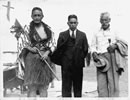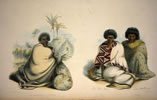Origins
The King movement (Te Kīngitanga) began in the 1850s, some years after the arrival of Europeans, in an attempt to halt sales of land and promote Māori authority in New Zealand. A number of tribes supported the movement, but it became centred on the Waikato region and people. The desire to retain land was a central concern of the movement, repeated in sayings, songs and haka. Here is an extract from an often-performed King movement haka:
Ka ngapu te whenua
Ka haere ngā tangata ki whea?
E Ruaimoko
Purutia!
Tāwhia!
Kia ū!
Kia ita!
A ita!
Kia mau, kia mau.
The earthquake shakes the land
Where shall man find an abiding place?
Oh Ruaimoko [god of the lower depths]
Hold fast!
Bind, tightly bind!
Be firm, be firm!
Hold, hold!
Hold fast the land.
The kings
In the 1850s tribes from all over the country, including the South Island, debated who should be offered the kingship. They finally agreed upon Pōtatau Te Wherowhero, the Waikato chief, who became first king in 1858. Pōtatau was succeeded by his son Tāwhiao in 1860. Tāwhiao’s reign coincided with the Waikato war of 1863–64, after which he led his people into exile in the lands south of Te Awamutu. This area is now known as the King Country. Tāwhiao, who was also a prophet, sustained the King movement in trying times and was succeeded by his son Mahuta in 1894.
King movement leaders
Pōtatau Te Wherowhero (1858–1860)
Tāwhiao (1860–1894)
Mahuta (1894–1912)
Te Rata (1912–1933)
Korokī (1933–1966)
Te Atairangikaahu (1966–2006)
Tūheitia Paki (2006–)
Mahuta became a member of the Legislative Council and the Executive Council of Parliament during his reign. He was succeeded by his son Te Rata in 1912. Te Rata continued the work of his father by negotiating with the New Zealand government and the British Crown, and by seeking redress for grievances. He was succeeded by his son Korokī in 1933. Korokī was a quiet man but nevertheless a leader of mana. During his time he was aided by his aunt, Te Puea Hērangi. Korokī was followed in 1966 by his daughter Te Atairangikaahu, and she was succeeded in 2006 by her son, Tūheitia Paki.




